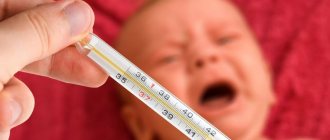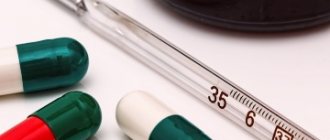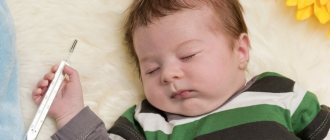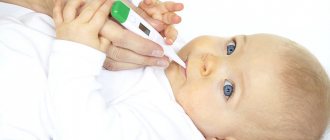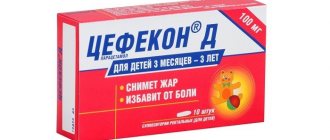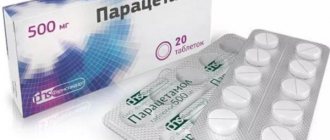An increase in temperature in a baby is a serious cause for concern for parents. But should you panic if the thermometer shows a little more than 37 degrees? When and how to lower the temperature? Let's figure it out.
www.stilnos.com
In newborn children (especially children under 3 months), the body's thermoregulation system is imperfect. The first few days after birth, the baby’s temperature can remain at 37-37.4 degrees.
Don't panic! Up to a year, slight fluctuations in temperature are considered normal, especially if the child has just eaten or has been naughty.
The way the baby is dressed can also affect the temperature: infants very easily overheat or, on the contrary, become hypothermic. Lack of drinking can also cause a slight rise in temperature in a child under one year old.
You cannot measure a baby's temperature:
- after meal;
- after a walk;
- after crying;
- After sleep;
- after swimming;
The temperature of a child under one year old is measured in different ways: in the armpit (normal is 36-37 degrees), in the inguinal fold, orally (normal is 36.9-37.4 degrees) and rectally (normal is 36.6-37.3 degrees). It is best to do this every day at the same time, when the baby is calm.
But, despite all of the above, the temperature of a child up to one year old needs to be monitored, because an elevated temperature can also indicate illness. If the baby is breathing heavily, is capricious and cries a lot, or, on the contrary, is very lethargic, refuses to eat, or shows signs of a cold, then it is unacceptable to ignore the fact that the child’s temperature is rising.
At a temperature of 38 and above, you should immediately call a doctor, since it is very difficult to independently determine the cause of a high temperature in a baby.
List of antipyretics for children under 1 year of age
What medicine should I choose for a baby to bring down the temperature? For children under one year old, the following options for antipyretic drugs can be used:
- Preparations based on paracetamol. This group includes medications such as Paracetamol, Panadol, Efferalgan. The list of drugs belonging to this group is quite wide. They are produced in the form of tablets, rectal suppositories and suspensions. Paracetamol has a softening effect on the body, so it can be used for fever in children from 2-3 months of age.
- Preparations based on ibuprofen. The list of this category of drugs includes drugs such as Ibuprofen, Ibufen, and Nurofen. You can resort to their help starting from 3 months. These drugs are contraindicated in the presence of pathologies of the kidneys, liver, asthma, as well as gastritis and ulcers.
- Antipyretic medications based on homeopathic preparations. This category includes the drug Viburkol, which is available in the form of rectal suppositories. The product has no age restrictions, but it is prohibited to use if there are problems with intolerance to the composition of the drug.
It is important to know! The drug, as well as the dosage, should be prescribed exclusively by the attending physician or local doctor.
Antipyretic drugs based on paracetamol in the form of syrup
Children from 3 months of age can be given 60 to 120 mg of paracetamol at a time. For children who have not reached 3 months of age, give Paracetamol syrup based on the calculation of the child's weight: 10 mg per 1 kg. You can give a child from 3 months Paracetamol syrup no more than 4 times a day.
- Panadol syrup. Prescribed in an amount of 4 ml for a child weighing from 6 to 8 kg. If the child weighs more, then 5 ml of syrup is prescribed.
- Efferalgan. You can use syrup starting from a child’s weight of 4 kg. Until the baby reaches a weight of 4 kg, it is not recommended to use the medicine.
- Calpol. Syrup is used for children from 3 months in quantities from 2.5 ml to 5 ml. It is not recommended to use the drug for up to 1 month.
When to lower the temperature of a child under one year old?
Remember that fever is not a disease, but a means of the body fighting the disease! If the child does not have respiratory or heart diseases, then it is recommended to give an antipyretic at a temperature above 38.5 degrees.
But if a child begins to have convulsions or has had them before, the temperature rises sharply at night, then an antipyretic should be given already at a temperature of 38 degrees.
If a child under 3 months has a temperature above 38 degrees on a weekend or holiday, call an ambulance. For children under 3 months, only a doctor should prescribe medication and dosage!
How to lower a child's temperature? Choosing antipyretic drugs
Causes of high temperature
High body temperature is a protective-adaptive reaction of the body in response to exposure to various pathogenic stimuli.
It is aimed at strengthening the body’s natural immune defense and creating conditions that prevent the proliferation of viruses and microbes in it. Body temperature within the range of 36.0–37.4 ° C is considered normal for a healthy child and can vary depending on the time of day, the child’s activity, food intake and other influencing factors.
Most often, an increase in temperature (fever) occurs during infectious diseases, among which acute respiratory diseases of the upper and lower respiratory tract (ARVI, influenza, bronchitis - inflammation of the bronchi, tracheitis - inflammation of the trachea, pneumonia - inflammation of the lungs), intestinal infections, etc. predominate. , an excessive increase in body temperature to high numbers (more than 39C) can not only disrupt the child’s well-being, but also lead to the development of life-threatening conditions such as cerebral edema, febrile convulsions (convulsions that occur in children aged 3 months to 5 years, associated with fever), further aggravating the course of the disease.
Timely use of antipyretics helps prevent such reactions. Antipyretic drugs are prescribed to children in the first 3 months of life at a temperature above 38oC, to children over 3 months (previously healthy) - at a temperature above 38.5–39oC. For children who have previously experienced febrile convulsions when their body temperature rises, or who have diseases of the heart, lungs, nervous system, etc., antipyretics are prescribed at temperatures above 38–38.5oC.
At the same time, parents should be aware that inadequate and unjustified use of antipyretics can change, hide the true cause of the disease, creating a feeling of imaginary well-being, and reduce the protective role of fever that stimulates the body’s immune response. In addition, uncontrolled use of drugs can lead to the development of side effects. Therefore, antipyretic drugs used in children must be highly effective and safe. Currently, the World Health Organization and national programs recommend the use of drugs containing only IBUPROFEN and PARACETAMOL for fever in children.
Antipyretic drugs: Paracetamol
Prescribed for fever as a result of viral or bacterial infections, as well as for mild or moderate pain during teething in infants, pain from burns, fractures and injuries, etc.
Use is permitted in children from the first month of life in the form of syrup and from 3 months of age in the form of rectal suppositories in doses strictly corresponding to the body weight and age of the child. The following drugs containing PARACETAMOL are most often used in children: EFFERALGAN, CALPOL, PANADOL, CEFEKON D.
A single dose for children from 1 month to 15 years is 10–15 milligrams per kilogram of body weight (mg/kg). This dose can be prescribed no more than 4 times a day, no more than 4 hours after taking the previous dose.
The maximum daily dose should not exceed 60 mg/kg.
Take orally in the form of tablets, syrup or suspension 1 hour after meals, with plenty of liquid. The drug in tablets can be used in children with allergies to the components of PARACETAMOL syrups or suspensions, since they do not contain dyes or flavoring additives. The tablet is dissolved in a small amount of water (after calculating the required number of milligrams of the drug depending on the child’s weight). Children weighing 13–15 kg or more can be given a whole tablet containing 200 mg of the substance.
For convenience, the packaging of rectal suppositories with PARACETAMOL usually indicates the age of the child, since the suppositories have the appropriate dosage of the drug. It is advisable to use rectal suppositories after bowel movements. It is especially convenient to use suppositories in young children with illnesses accompanied by vomiting, loss of appetite, or refusal to take medications orally.
It is quickly absorbed in the intestines and within 30–45 minutes has a therapeutic effect that lasts 2–4 hours. To avoid the development of side effects from taking the drug, the recommended dose should not be exceeded, and the duration of treatment should not be more than 3 days without examination and advice from a doctor.
Attention! In rare cases, it is possible to develop adverse reactions from the gastrointestinal tract (nausea, vomiting, abdominal pain), allergic reactions (skin rash, itching, urticaria, Quincke's edema), toxic damage to the liver and kidneys, inhibition of blood cell formation, etc. In this case, consult a doctor immediately. Taking PARACETAMOL is contraindicated for children with severe renal and liver dysfunction, blood diseases, and individual intolerance to the drug.
Antipyretics: Ibuprofen
Used in case of intolerance or insufficient effect of paracetamol preparations. NUROFEN for children containing IBUPROFEN is used from 6 months of life as an antipyretic for acute respiratory diseases, influenza, childhood infections, post-vaccination reactions and other infectious and inflammatory diseases accompanied by an increase in body temperature. The drug is available for children in the form of a suspension and rectal suppositories for administration into the rectum. For ease of dosing, a measuring syringe is included with the suspension box.
It has antipyretic, analgesic and anti-inflammatory effects, acting at the level of the central nervous system and the peripheral level and is the first choice drug in children with a combination of fever and pain as a result of infectious and inflammatory diseases (otitis - inflammation of the ear, tonsillitis - inflammation of the tonsils, toothache), as well as in the treatment of acute pain from burns, injuries, inflammation of muscles and joints.
A single dose in children is 5–10 mg/kg body weight; this dose can be prescribed 2-3 times a day every 6-8 hours.
The maximum daily dose should not exceed 25–30 mg/kg.
Considering the irritating effect on the gastrointestinal tract, it is not advisable to take the drug on an empty stomach: before giving the medicine, try to feed the baby at least a little. It is advisable to insert a rectal suppository into the rectum after bowel movement.
The effect occurs 30–60 minutes after administration, and the maximum effect is observed after 2–3 hours. In addition, the duration of its antipyretic effect is longer than that of PARACETAMOL - up to 8 hours.
The use of IBUPROFEN, like any antipyretic drugs, should not last more than 3 days without examination by a doctor. Long-term use increases the risk of developing side effects of the drug.
Side effects when taking IBUPROFEN are observed mainly in the gastrointestinal tract (abdominal pain, nausea, vomiting, stool disorders), allergic reactions are possible (urticaria, bronchospasm), less often - changes in the blood, a tendency to bleeding, impaired liver and kidney function . If side effects occur, take your baby to the doctor immediately. Contraindicated for children with gastrointestinal ulcers, blood diseases, severe renal and liver dysfunction, or hypersensitivity to the drug.
Antipyretic drugs: Analgin and amidopyrine
At high temperatures (more than 39–39.5oC) in children, as well as with fever accompanied by severe intoxication (a pathological condition caused by the effect of toxic substances of internal or external origin on the body), peripheral vasospasm (severe pallor of the child’s skin), in case of threat or the occurrence of febrile seizures, sometimes there is a need to lower the temperature more quickly. This means that the child needs to be prescribed antipyretic drugs in parenteral form (intravenously or intramuscularly). The drug of choice in such a situation will be ANALGIN or AMIDO PYRINE. It should be noted that only short-term, one-time use of these drugs in children is possible due to the threat of severe side effects from their use.
The drugs can be administered either alone or in combination with antispasmodic drugs (NO-SPA, DIBAZOL, PAPAVERINE). Antihistamines (TAVEGIL and SUPRASTIN) are used together with these drugs. At home, it is possible to administer intramuscularly a 50% or 25% analgin solution, 0.1–0.2 ml of solution per year of a child’s life, no more than 3–4 times a day. However, in such situations, it is better to entrust the procedure for parenteral administration of the drug to medical personnel by calling an ambulance at home. Parents should remember that if the temperature rises to 39–39.5oC, the baby must be shown to a doctor as soon as possible.
How to take antipyretics
You can use medications to lower body temperature only after assessing all the indications and the need for their use (age and health characteristics of the child, his well-being, lack of effect from physical cooling methods, increase and high fever figures).
Antipyretic drugs should not be used to prevent a new rise in temperature - they should be used only when the child’s body temperature rises again to the previous levels.
You should strictly adhere to the recommended single dosage of the drug depending on the age of the child, in no way exceeding the permissible daily dose.
Antipyretics should not be given for more than 3 days without examining the baby by a doctor due to the risk of developing a bacterial infection and late prescription of antibacterial agents.
It is not recommended to take several antipyretic drugs at the same time due to a possible sharp decrease in the baby’s body temperature to low numbers and the development of side effects.
If fever develops with spasm of the skin vessels (cold, pale hands and feet, marbling of the skin) after the administration of an antipyretic drug, it is necessary to rub the child’s skin until it turns red and urgently call a doctor.
If you experience side effects from taking antipyretic drugs, you must inform your doctor.
Before using any antipyretic drug, you must carefully read the package insert, paying attention to the appearance, dosage, and expiration date of the drug.
Despite all the recommendations for the use of antipyretics, children with fever should be examined by a doctor in the near future to determine the cause of the fever and prescribe proper treatment.
How and with what to reduce the temperature of a child under one year old?
Before the doctor arrives, it would be a good idea to try to bring down the temperature using non-drug methods . Due to the imperfect thermoregulation system of the baby's body, such methods are usually quite effective.
Firstly, ventilate the room more often, after taking the baby to another room.
Secondly, if the child does not have a chill, take off his warm clothes; it is best to leave him naked, just cover him with a diaper.
Thirdly, dip a gauze cloth in water at room temperature and squeeze it out, then wipe the child’s face, neck, arms, legs, and body.
Fourth, let your baby drink more often.
Fifthly, if the baby is sleeping, do not wake him up without an important reason, for example, a doctor's visit (feeding is not an important reason!).
If traditional methods do not help, and the temperature has exceeded 38.5 degrees, the baby should be given an antipyretic .
Needless to say, it is worth discussing this issue with your doctor in advance? x
Antipyretic for a newborn - rules of administration
In order not to harm the baby, but to really help, you need to know how to properly give your child antipyretics.
- This type of medication should not be given in courses. That is, a remedy for fever should be given only if it rises.
- Antipyretics should not be given as a preventative measure. The only exception is taking these drugs after DTP vaccination.
- The maximum permissible daily dosage of the drug should not be exceeded. In this case, you need to be especially careful when using paracetamol-based products. This is due to the fact that this drug accumulates in the body and negatively affects the kidneys and liver.
- If a child has been prescribed antibiotics, the antipyretic should not be given for long. After all, by lowering your body temperature, you “blur” the picture of the action of the antibacterial drug, which should reduce the temperature in a couple of days. If you continue to lower your temperature with antipyretic drugs, the doctor will not be able to adequately assess the prescribed antibiotic treatment, and you will waste time by advancing the disease.
Antipyretics: dosage forms
Medicines for fever for newborns are available in 2 forms:
- Solid - rectal suppositories. The advantage is ease of administration, subject to simple rules, the absence of unnecessary dyes and flavors that can cause allergies. Disadvantage - the need to store antipyretic suppositories in the refrigerator, the action is slower than that of liquid preparations.;
- Liquid - syrups, suspensions. The main advantage of such drugs is their rapid effect - the active substance penetrates the blood faster than in the case of rectal suppositories. However, to obtain a more pleasant taste for the child, manufacturers add sweeteners to the preparations, which can provoke diathesis. But it’s more convenient to store the products - you don’t have to put them in the refrigerator.
Approved antipyretic drugs effectively and safely help cope with fever if the instructions are followed.
Rules of application
Liquid medications are given using special pipettes or syringes that are included in the kit. Giving medicine to a newborn from a spoon is acceptable, but quite problematic. Many parents are faced with the fact that the child spits out the medicine, so they prefer rectal suppositories.
To insert the suppository, the child is placed on his side, the legs are raised towards the tummy and the suppository is carefully inserted into the anus. To facilitate the process, you can use oil or baby cream. Sometimes children are capricious and resist, but many mothers note that lighting a candle is much easier than giving syrup.
Remember that antipyretics are symptomatic, not course or preventive therapy. They are not given according to a schedule, but are used strictly when it is necessary to reduce the temperature. In this case, the total duration of treatment should not exceed 3–5 days. It is necessary to maintain intervals between medications for at least 4–6 hours to avoid overdose.
